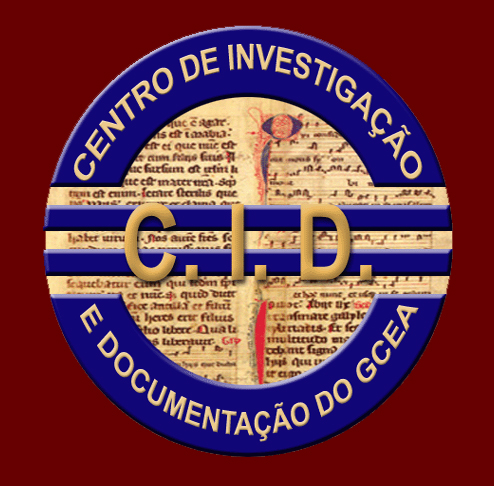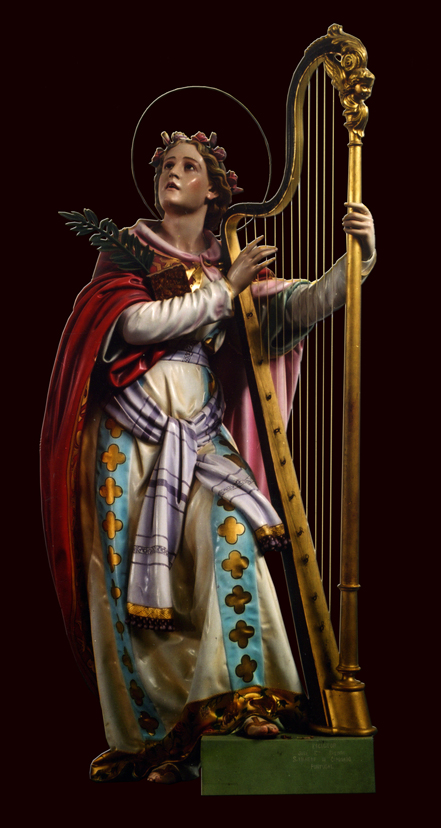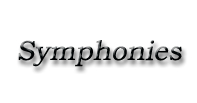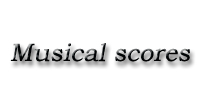

 |
 |
Saint Cecily Symphonies in Madeira
|
|||||||||||||||||||||||||||||||
Bearing into consideration that Saint Cecily is the patroness of musicians it is consequently understandable that, in the course of History, several compositions have been dedicated to her. The very first references to Saint Cecily cult in Madeira, concerning festive music, have been found in an article by Lieutenant Colonel Alberto Artur Sarmento entitled “Saint Cecily”. In that text, Sarmento refers to a distinctive celebration dedicated to Saint Cecily, held in Santa Clara's church in 1844, and attended by numerous inhabitants from Funchal. As Sarmento points out, quoting the newspaper «O Imparcial», this event was held as an answer to the Liberal attacks which had been produced against the Catholic Church. For that reason, the celebration was organized so that “music enthusiasts also take part in the immense fight to which all good Catholics of this town are engaged opposing the deceitful heretical, alarming us”. Accordingly, the Saint Cecily cult and the use of pompous music in religious rituals were some of the ways found by the Church to answer back the hostile political attacks held against the Institution. It counted on several composers that took part in that struggle writing several compositions for religious celebrations. |
|||||||||||||||||||||||||||||||
Nevertheless, exception made to the 1844 ceremony described by Sarmento, no other evidence of festive music ceremonies on Saint Cecily day (22 nd November) or the neighbouring Sundays, were found in religious newspapers, contemporaneous to Nuno Lino and César Nascimento ( Boletim Eclesiástico; Quinzena Religiosa da Ilha da Madeira; A Verdade ). Consequently, we cannot find data confirming that the works presented in this compilation have been composed on purpose for Saint Cecily day, even though such hypothesis is not refuted in this research work. |
|||||||||||||||||||||||||||||||
We should still take into account the testimony of three generations of musicians that have played some of the religious symphonies at the beginning or the end of Eucharist celebrations. Despite the title of these compositions, they were played during whatever festive religious services, not necessarily on Saint Cecily day. This leads us to hypothesise that they have been composed for a festive Mass. Still, considering their title it appears more verisimilar that they have originally been composed for Saint Cecily day and subsequently played in other religious festive ceremonies. On the other hand, the hypothesis supporting that they were composed for Saint Cecily parish, in Câmara de Lobos, should be given little credit. Beyond the fact that both composers are from Funchal, that parish was only created in 1960, a time very posterior to the composition of the above mentioned symphonies. An interesting fact is that some of these symphonies have been performed during several decades – even after their authors had passed away – and this is proof of their great success in Madeira. According to the testimony of some musicians, these symphonies were still played in the eighties and nineties of the past 20 th century during festive Masses, mainly in Summer, at the local religious celebrations. The festeiros – a group of individuals responsible for the organization of these celebrations – paid the musicians to play during Eucharist celebrations and the repertoire of several pompous instrumental music pieces included Saint Cecily symphonies usually played at the beginning or the end of the ceremony. As a conclusion, we know that these symphonies were part of the festive masses repertoire where they were played during several decades, but the when and what for they where originally composed remains an open-ended question. |
|||||||||||||||||||||||||||||||
Brief stylistic description of the symphonies Nowadays, when we refer to Symphony as a musical genre, we relate it to the Classical School of Vienna, mainly to the works of Haydn, Mozart and Beethoven which have inspired the eastern instrumental music of the 19th and the 20 th centuries. The Viennese symphonies were in general large-scale works of great breadth, full of rich orchestrations, generally in four movements. Madeiran symphonies dedicated to Saint Cecily have little connection with this Viennese model, besides the fact that in both cases we are dealing with instrumental works. This way, the term Symphony should, in this precise context, be understood in a wider meaning. This should take into consideration that it might have been used by Madeiran composers, from the 19 th and the first half of the 20 th century, to refer to all the exclusively orchestral works following the Italian tradition of the beginning of symphonic genre where symphony meant the orchestral works - in opposition to vocal works – without a formal structure. Furthermore, stylistically the Madeiran symphonies reveal a great influence of 18 th and 19 th Italian music as we may conclude by the following: |
 |
||||||||||||||||||||||||||||||
(1) The symphonies indicate a strong lyrical and melodic element, presenting some virtuoso and highly ornamented moments, of a very flexible texture without any relevant counterpoints or any other type of intense textures; (2) Harmonies are tonal and of little complexity. There are no moments of great harmonic tension or of an ambiguous tone; (3) The instrumental device is mastered by violins, showing a scarce tonal variety, in a religious orchestra which was normally composed by one flute, two violins, one cello, one contrabass and a pipe organ; (4) The rhythm follows a quadrature and symmetry, presenting no complex or asymmetric rhythmic moments; (5) In the aesthetic plan, symphonies present a more festive than religious or mystic feature; moreover, in some moments, the arrangement for this instrumental grouping seems to function like a festive March of a philharmonic band as well. (6) From a formal point of view, compositions do not rigidly follow the classical sonata form, or a pattern form whatsoever, the composers having opted for the creation of a succession of musical sections, presenting an internal tonal and thematic contrast. This formal scheme may be perceived in the symphony composed by Nuno Lino that we present in the following frame: |
|||||||||||||||||||||||||||||||
Frame – formal scheme of Nuno Lino's symphony
|
|||||||||||||||||||||||||||||||



